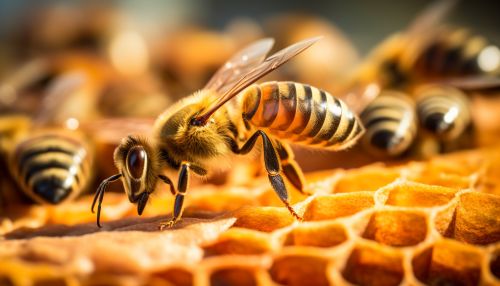Queen bee
Introduction
The queen bee is the adult, mated female in a honey bee colony or hive; she is usually the mother of most, if not all, the bees in the beehive. Queens are developed from larvae selected by worker bees and specially fed in order to become sexually mature. There is normally only one adult, mated queen in a hive, in which case the bees will usually follow and fiercely protect her.
Biology


Anatomy
The queen bee's body is longer than the worker bees surrounding her. In a hive of a honey bee, the queen is the largest bee. With a length of 20 mm (0.79 in), her abdomen is long and typically darker than her multicolored workers. Queens, however, are variable in color and may be nearly as light as their workers.
Development
The queen bee's development begins when a young larva is fed a special diet, known as "royal jelly", by worker bees. Royal jelly is a honey bee secretion that is used in the nutrition of larvae, as well as adult queens. It is secreted from the glands in the hypopharynx of worker bees, and fed to all larvae in the colony. When worker bees decide to make a new queen, either because the old one is weakening, or was killed, they choose several small larvae and feed them with copious amounts of royal jelly in specially constructed queen cells. This type of feeding triggers the development of queen morphology, including the fully developed ovaries needed to lay eggs.
Reproduction
The queen bee is the only bee in the hive which is allowed to reproduce. She has a sting, but doesn't leave the hive to help defend it. Her main purpose is to produce more bees. A well-mated and well-fed queen of quality stock can lay about 1,500 eggs per day during the spring build-up—more than her own body weight in eggs every day. She is continuously surrounded by worker bees who meet her every need, giving her food and disposing of her waste. The attendant workers also collect and then distribute queen mandibular pheromone, a pheromone that inhibits the workers from starting queen cells.
Role in the Colony
The queen bee's primary function is to serve as the reproducer; she is the mother of worker bees and drones. The queen's activity within the hive is regulated by the weather conditions outside the hive and the availability of resources. The queen bee is the only bee in the hive which is allowed to reproduce. She has a sting, but doesn't leave the hive to help defend it. Her main purpose is to produce more bees.
Queen Mandibular Pheromone
The queen bee releases pheromones that serve to regulate the activity of the worker bees and drones within the hive. One of these, the queen mandibular pheromone (QMP), is a key tool for the queen to maintain her dominance in the hive. QMP affects a variety of worker behaviors including inhibition of queen rearing, attraction of workers and drones, stimulation of worker retinue behavior, inhibition of worker ovary development, and regulation of foraging.
Queen Rearing
Queen rearing is the process by which beekeepers create new queen bees for their colonies. This is done by manipulating the conditions of the hive to induce the worker bees to create new queen cells. The larvae in these cells are then fed with royal jelly, resulting in the development of a new queen bee.
Queen Replacement
When a queen bee is going to die or become unproductive, the hive will start to produce a new queen. This process is known as "supersedure". Supersedure may also occur if the queen is lost, for example through death or because the beekeeper has removed her.
